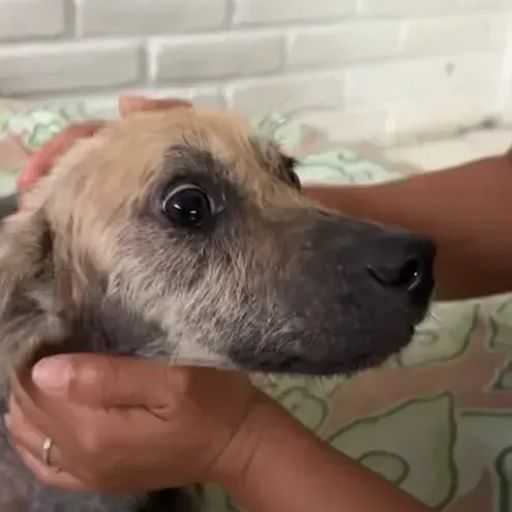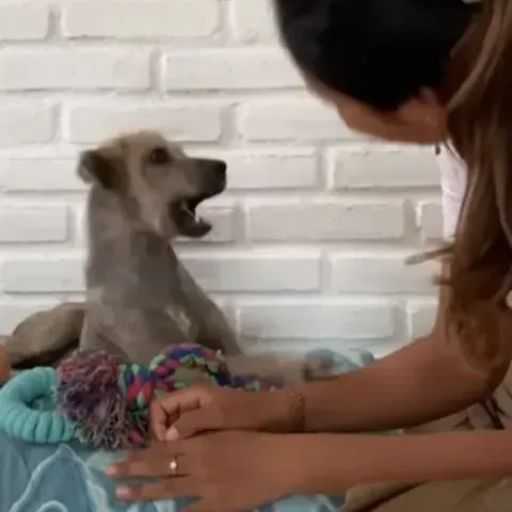Sabine, a volunteer with a heart brimming with compassion for animals in need, received a call that would forever change the life of a dog named Lisa. The caller described a harrowing scene – a dog, frail and alone, found tied up in a desolate area. Dehydration had ravaged her body, her fur was matted with a skin disease, and a dark shadow of early-stage cancer loomed over her. Sabine rushed to the scene, her heart heavy with a mixture of dread and determination.

The sight that greeted Sabine was enough to break anyone’s spirit. Lisa, a mere shell of her former self, whimpered weakly, her eyes dull with pain and neglect. Sabine could feel the dog’s frail bones beneath her matted fur, and a wave of anger and sadness washed over her. How could anyone abandon a creature in such a deplorable state?

Without a moment’s hesitation, Sabine scooped Lisa into her arms and rushed her to the nearest veterinary clinic. The vet, a kind soul with years of experience treating animals in distress, examined Lisa with a gentle touch. The diagnosis confirmed Sabine’s worst fears – dehydration, a severe case of mange, and the presence of cancerous cells. Yet, amidst the grim picture, the vet found a flicker of hope. Lisa’s weak tail thumped faintly against the examination table, a testament to her will to fight.

The days that followed were a blur of intensive care. Lisa received fluids to replenish her dehydrated body, medication to combat the mange, and treatment to slow the progression of the cancer. Slowly, a spark returned to her eyes. Her tail began to wag with newfound vigour, a silent thank you for the kindness she received. After five long days at the clinic, Lisa was strong enough to move to a safe house, a temporary haven for animals on the road to recovery.

The safe house was a lively place, filled with the barks and playful yips of other rescued animals. At first, Lisa was overwhelmed by the sights and sounds. The years of neglect had made her wary of human interaction, and the boisterous energy of the other dogs filled her with apprehension. But the volunteers at the safe house were patient and understanding. They showered Lisa with gentle affection, allowing her to adjust to her new surroundings at her own pace.

One day, a young volunteer named Sarah brought Lisa a soft, colourful squeaky toy. Lisa, hesitant at first, sniffed the toy cautiously. Then, with a tentative nudge, the toy squeaked. A surprised yelp escaped Lisa’s throat, followed by a flicker of playful curiosity in her eyes. Sarah, sensing a breakthrough, tossed the toy a short distance. To everyone’s delight, Lisa chased after it, her tail wagging furiously. It was a small victory, but a victory nonetheless.

As weeks turned into months, Lisa blossomed into a playful and affectionate dog. The mange had cleared, revealing a coat of soft, brown fur. Her once-dull eyes sparkled with a newfound zest for life. Lisa, once a victim of cruelty, now revelled in the simple joys of haven life – belly rubs, walks in the park, and playful tussles with her newfound canine companions.

Sabine, who had fostered a special bond with Lisa during her clinic visits, knew Lisa deserved a forever home. She created a profile for Lisa, highlighting her gentle spirit, her playful side, and her love for adventure.

As Lisa grew older, her playful puppy energy matured into a calm and affectionate demeanour. Though a little shy when meeting new people, she quickly warmed up to those who offered her kindness. Sabine knew Lisa was ready for her forever home, a place where she would be cherished and spoiled rotten.

The wait for the perfect family continued. Every day, Sabine hoped that someone would see the incredible dog Lisa truly was – a dog who had overcome immense hardship with unwavering resilience, a dog whose heart overflowed with love and a zest for life. Lisa’s story was a testament to the unwavering spirit of a dog and the boundless compassion of humans who dedicated themselves to her care. It was a story of hope, of second chances, and a reminder that even in the face of despair, a tail can wag again.

Watch The Full Video Here:
Ever wondered how your furry companion views the world around them? Understanding how dogs perceive color is like peering through their eyes into a vibrant, yet different, reality. You might be surprised to learn that the colors they see aren’t quite the same as what you see. It’s like watching a movie where the hues are slightly altered, adding a unique twist to their visual experience.
As a seasoned dog trainer, you’ve probably noticed how color can influence a dog’s behavior and reactions. Knowing more about their visual perception can deepen your bond with them and enhance your training methods. So, let’s take a closer look at the fascinating world of how dogs see color and how it shapes their interactions with the environment and with you.
The Science Behind Dog Vision
Dogs’ color vision isn’t as vibrant as yours. They see the world in a range of yellows, blues, and grays. Your pooch lacks the ability to see the full spectrum of colors like you do.
Cone Cells
Your furry friend has fewer cones in their eyes than you, making their color vision limited. While you have three types of cone cells, dogs only have two. This affects their perception of colors, especially reds and greens.
Dichromatic Vision
Dogs have dichromatic vision, which means they see two main colors: blue-violet and yellow. Reds appear brownish-gray to them, and greens may seem yellowish. This impacts how they distinguish objects based on color.
Superior Night Vision
Although dogs struggle with color vision during the day, they excel under low-light conditions. They have a higher number of rod cells in their eyes, enhancing their ability to see in the dark. This adaptation stems from their history as nocturnal hunters.
Practical Implications
Understanding how dogs see color is crucial for tailoring their training techniques. Using color cues might not be effective, but they respond well to contrasts in brightness. Consider this when teaching your furry companion new tricks.
Enhancing Your Bond
By recognizing your dog’s visual abilities, you can strengthen your bond with them. Appreciating their unique way of seeing the world helps you communicate more effectively and build a deeper connection.
Conclusion
Dog vision’s science reveals their world of colors. While they may not see like humans, their visual abilities are finely tuned for hunting and navigating in different light conditions. Appreciating these differences can make you a better companion to your furry friend.
Can Dogs See Colors?
So, can dogs see colors? Well, they see the world a bit differently from how we do. Dogs have two types of cone cells in their eyes, compared to our three, which means their color vision is limited. They see the world in shades of blue-violet and yellow, with other colors appearing more muted to them.
- Limited Color Range: Dogs have a reduced ability to distinguish between different colors, unlike humans. Their color perception is more akin to that of a color-blind person, with a palette restricted to blue-violet and yellow tones.
- Vibrant Night Vision: While their color vision may not be as vibrant, dogs excel in low-light conditions. Their night vision is due to a higher number of rod cells in their eyes, permitting them to see well in the dark.
- Focusing on Contrasts: Understanding that dogs perceive the world in a more limited color spectrum can help you tailor your training techniques. Instead of relying on color cues, focus on using brightness contrasts for effective communication with your furry friend.
- Enhancing Communication: Recognizing and appreciating the unique visual abilities of your dog can strengthen the bond between you. By understanding their perspective, you can improve communication and deepen the connection with your canine companion.
In essence, while dogs may not see the world in all its colorful glory like we do, their unique visual capabilities enrich your interactions with them. By adjusting your training methods to accommodate their limited color vision, you can enhance your communication and deepen the bond with your beloved pet.
Do Dogs Prefer Certain Colors?
Dogs don’t have specific color preferences like humans. They see the world in hues of blue and yellow, so their color choices may differ from ours. Since dogs have dichromatic vision, they’re less sensitive to reds, greens, and oranges that stand out for us. However, they can differentiate various shades of blue and yellow.
When choosing toys or accessories for your furry friend, opt for colors in their visible spectrum. Blues and yellows are good choices as they can see these shades more clearly. Avoid red or green toys as they might appear as shades of gray to your dog. Picking toys in their visible range can make playtime more enjoyable for them.
While dogs might not have favorite colors, they do react to contrasts in colors. They are drawn to high-contrast items, making them easier to spot. For example, a bright yellow ball on a green field will be more visible to your dog than a red ball in the same setting. Using contrasting colors in training aids visibility and enhances your dog’s focus.
Understanding your dog’s color perception can help create a colorful world tailored to their vision. By selecting toys and training tools that consider their dichromatic sight, you can enrich their visual experience and strengthen your bond. Experiment with different colors to find what catches your dog’s attention and makes their world brighter.
Factors Influencing Dog Perception of Colors
Understanding how dogs perceive colors can help you create a stimulating environment for your furry friend. Here are some key factors that influence a dog’s perception of colors:
1. Dichromatic Vision
Dogs have dichromatic vision, meaning they see the world in shades of blue-violet and yellow. Reds, greens, and oranges appear more muted to them.
2. Color Preferences
Dogs do not have specific color preferences, but they can differentiate between shades of blue and yellow more easily.
3. Visible Spectrum
Toys in blue and yellow hues are clearer to dogs. Opting for these colors can make playtime more enjoyable for them.
4. Contrast Sensitivity
Dogs are drawn to high-contrast items. Using contrasting colors in training sessions can be more effective in capturing their attention.
5. Enriching Their Visual Experience
Adapting to your dog’s color perception can make their world more vibrant and tailored to their vision. This understanding strengthens the bond between you and your canine companion.
By considering these factors and adjusting your dog’s surroundings accordingly, you can enhance their visual experience and ensure a brighter, more engaging world for them.
Common Myths About Dog Color Vision
Dog Color Blindness:
Dogs are not completely color blind; they see the world differently, with fewer color hues than humans. While dogs have dichromatic vision and can’t see the full spectrum of colors, they can still perceive blues, yellows, and shades of grays.
Dogs Only See in Black and White:
Contrary to the popular belief that dogs only see in black and white, they do see colors, just not as vividly as humans. Dogs’ color vision is similar to red-green color blindness in humans.
Dogs Can’t Differentiate Colors:
Although dogs can’t see all colors like humans do, they have a partial color spectrum vision. Dogs can distinguish between different colors, especially blue and yellow, which appear more prominent to them.
Red is Invisible to Dogs:
While red appears more muted to dogs compared to humans, they can still see it. Dogs perceive red as a shade of gray or similar to the way humans with red-green color blindness see it.
Only Certain Colors Attract Dogs:
Even though dogs have limited color vision, they are attracted to high-contrast colors like blue and yellow. Toys and objects in these colors are more visible to them, making playtime more engaging and enjoyable.
Vibrant Colors Confuse Dogs:
Bright, vibrant colors can be confusing for dogs due to their limited color perception. It’s best to use contrasting colors for training and interacting with your furry companion for better visibility.
Adjusting Your Dog’s Environment:
Understanding how dogs see colors can help you enrich their visual experience. Adapting their surroundings with colors they can distinguish easily, like blues and yellows, can make their world more colorful and stimulating.
Tailoring Interaction to Your Dog’s Vision:
By considering your dog’s color vision abilities, you can enhance your bond with them. Using contrasting colors for training, playtime, and setting up their environment can make a significant difference in how they perceive the world around them.
Conclusion
So, there you have it – dogs may not see the world in all its colorful glory like we do, but they’ve got their own unique way of viewing things. With their keen ability to spot blues and yellows, our furry friends navigate the world in their own special palette. By incorporating these colors into their toys and training gear, you can make their playtime more engaging and their learning experiences more effective. Remember, understanding how your dog sees the world can deepen your connection and make every moment you spend together even more vibrant. So, next time you’re out shopping for your pup, think blue and yellow for a tail-wagging good time!
Frequently Asked Questions
Can dogs see colors?
Yes, dogs can see colors, but they have dichromatic vision limited to blue-violet and yellow hues, similar to red-green color blindness in humans.
What colors can dogs see?
Dogs can see blues, yellows, and shades of gray more vividly than other colors due to their limited color perception capabilities.
How does understanding a dog’s color vision help?
Understanding a dog’s color vision can enhance playtime and training effectiveness by using high-contrast colors that dogs can easily differentiate.
How can I enrich my dog’s visual experience?
To enrich your dog’s visual experience, adapt their environment to colors they can easily distinguish, such as blues and yellows, to strengthen the bond between you and your furry friend.

Hey there, I’m Janet Brooks, a dog-loving student from California. I’m all about helping pups in need, especially those without homes. Me and my awesome friends work together to give shelter and love to stray dogs. Oh, and I also write blogs about dogs to share helpful info.